This month, we’re doing daily reviews of the second season of Daredevil. Check back daily for the latest review.
Throughout the second season of Daredevil, major characters debate the nature of Frank Castle.
In Bang, Frank Castle is introduced as a force of nature; he is presented akin to an old horror movie monster. In New York’s Finest, Frank tries to argue his case with Matt; Frank suggests that he simply offers a more permanent variation of the justice that Matt dispense. Indeed, Regrets Only seems to suggest that Karen has a more sympathetic perspective on Frank; Foggy dismisses him as obviously insane. In Semper Fidelis, Matt and Karen argue about whether Frank could be considered a hero.

“You should put that on a t-shirt or something.”
As the second season of Daredevil marches on, the series continues to offer excuses and justifications for what Frank does. The show goes out of its way to avoid any potentially challenging read of Frank Castle, tying everything neatly back to the death of his family. Guilty as Sin implies that Frank is a victim of “sympathetic storming” that keeps the death of his family constantly fresh in his mind. Seven Minutes in Heaven makes it clear that Frank still has a lot killing to do to avenge his family. Frank is presented as a brutal avenger, rather than a violent serial killer.
However, as the second season of Daredevil enters its final act, the show tips its hand. The Man in the Box makes it clear that Frank Castle is not an anti-villain. He is not even an anti-hero. Frank Castle is a straight-up hero. As the show moves into its final stretch, it becomes clear that the production team have crafted a thirteen-episode superhero origin story for Frank Castle. That gets to the root of the problems in his characterisation.

Sai.
In interviews around the launch of the second season, the production team talked a lot about making Frank Castle relatable and understandable. As Charlie Cox explains:
When there is a gun crime of some sort or any sort of violence, the first emotional reaction I have when I read the paper and see the headlines is, “Mother%#!?er, I can’t believe this guy! How awful! That person is the epitome of evil!” And then, you read further into the article and, if it’s a good publication, what you then begin to read about is their background, their history, their childhood, that person’s experiences, their life and how life treated them. Then, you start to have a very uncomfortable feeling like, “Wow, maybe we did this.” There’s a great expression, hurt people hurt people. That’s something that happens in our show a lot. In other films and TV shows, we might say, “Well, they’re just evil.” In our show, we’re trying to say, “There’s bad actions, but not necessarily bad people.”
The production team is being disingenuous here. Given the abundance of white male gun-totting vendetta-driven protagonists, it would actually be more daring to embrace the more uncomfortable aspects of the character.
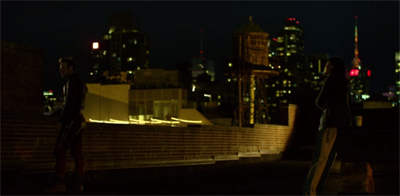
Ceiling the deal..
After all, films like Taken have demonstrated that the righteous gun-totting avenger is an archetypal fixture of popular culture. Audiences can be trusted to root for a grim murdering protagonist, if their violence is tied to rescuing (or avenging) a sufficiently sympathetic victim. In most cases, this is a father protecting a child. Countless films come to mind; from Run All Night to Stolen to 3 Days to Kill to The Cold Light of Day. The victimisation of a female or infant character provides the audience with a justification for the ensuing carnage.
The second season of Daredevil has largely shied away from any potentially problematic reading of Frank Castle by offering the most reductive possible reading of the character. Frank Castle was a soldier who turned into an avenging angel when his family was taken from him. The show never seems particularly engaged with questions about Frank’s moral authority or his choice of victims. Everything over the second season of Daredevil aligns to ensure that the audience feels perfectly justified in supporting his roaring rampage of revenge.

Deaf to his appeals…
Consider Frank’s victims over the course of the first season. The vast majority of Frank’s victims have been directly tied to the death of his family, thus justifying his actions. In Bang, Frank murders the Irish at a gangland summit they are holding to boast about how evil they are and hangs members of the Cartel from meathooks in a freezer which seems reasonable because they’d likely do worse. In New York’s Finest, he has Grotto confess to double homicide before killing him. In Penny and Dime, Finn recognises Castle by the tickets to the carousel.
On the rare occasion that Frank kills somebody who is not directly related to the death of his family, the show is careful to frame it in the least ambiguous manner possible. Frank murders Dutton in Seven Minutes in Heaven for his part in the drug deal, but then has to murder an entire hallway full of convicts in self-defense. When Frank murders the pawn shop owner in Dogs to a Gunfight, the show works incredibly hard to signpost the character’s evil nature; not only does he have a Nazi tattoo clearly visible on his neck, but he is selling child pornography.

DA DOA.
That commitment to keeping Frank “likable” plays through into The Man in the Box. Early in the episode, District Attorney Reyes is murdered by a sniper. Everybody assumes that Reyes was killed by Frank Castle, in retribution for her part in the death of Frank’s family. After all, Reyes organised the operation without clearing the park. However, she also worked really hard to cover her crimes; she signed a “do not resuscitate” order for Frank Castle and a “shoot to kill” order on the Punisher. She doctored reports and buried the truth.
However, Karen is convinced that the Punisher did murder Reyes. Karen never explains why the Punisher would not have murdered Reyes. The murder is committed with the sort of tactical precision that Frank brings to his work, minimising potential civilian casualties while eliminating a character who is morally responsible for playing some part in the death of his wife and children. It is perfectly reasonable for Matt and Foggy to assume that Frank Castle did kill Reyes, and it makes perfect sense in terms of the story.
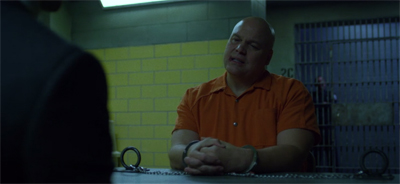
Where there’s a Wilson…
Ultimately, Karen is correct. Frank did not murder Reyes. The Dark at the End of the Tunnel reveals that Colonel Schoonover has attempted to frame Frank for the murder of Reyes as an effort to cover up his involvement in a highly lucrative heroin-smuggling ring. Left unspoken is the suggestion that Karen was correct, and that Frank did not murder Reyes. More than that, the show seems to suggest that the assumption that Frank would actually murder Reyes is based upon a fundamental misunderstanding of his character.
The implications of this are troubling on multiple levels. Why wouldn’t Frank kill Reyes? After all, she is a criminal by any measure. Frank showed no hesitation when it came to killing Dutton and Schoonover, two criminals involved in the deal who may not have actually been present on the day in question. What makes Reyes a less acceptable or desirable target to Frank? Why is Karen right when she insists that Frank would not have killed the District Attorney? A number of unspoken possibilities present themselves, and none are particularly flattering.

All good in the hood…
The most obvious difference between Reyes and the Punisher’s other victims is the fact that Reyes is a District Attorney. She is in a role that is traditionally considered public in nature; she is a civil servant, a good citizen. She is not a soldier like Schoonover nor an obvious criminal like Dutton. This suggests that Frank’s war on crime has its own rules of engagement that would exclude such public figures in professional roles in favour of more traditional criminals.
It suggests an uncomfortable element of class to what the Punisher does, as if to imply that Reyes’ sharp suits and official position meant that she was not his “type.” Portrayals of The Punisher have traditionally been very careful in depicting his targets. Most comics and films have been very careful to pit Frank against predominantly white criminals; the Italian and Irish mobs frequently find themselves under siege from Frank Castle. Even within the second season, his war with the Cartel gets less focus than his work on the Kitchen Irish or the Dogs of Hell.
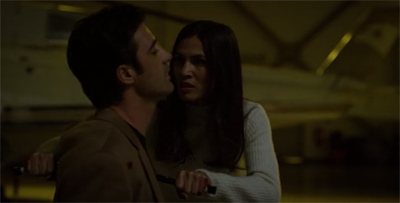
The heart of the matter…
There are a number of reasons why stories focusing on Frank Castle are so careful around issues of race. After all, depictions of urban crime in America can easily become racially problematic. One need only look at director Michael Winner’s work on the Death Wish trilogy, with Devin Faraci pointing to the original as a film that “doesn’t quite have the cojones to be full on racist” and even his eulogies acknowledging the “casual racism” of the series. Even outside of film, consider the loaded use of the word “thug” – to pick one example.
More than that, many real-life cases of vigilante justice – including Bernie Goetz and George Zimmerman – are tied up in racial politics. Not to mention questions about the disproportionate use of force by lawful authorities against minorities. So it makes sense for stories about the Punisher to play it safe by falling back on clichés about Italian American and Irish American criminal enterprises, even though those elements feel as dated as Daredevil‘s depiction of Hell’s Kitchen as a rotting cesspool of corruption and decay.

Duck and cover…
However, even as Daredevil avoids any potentially problematic racial subtext to the Punisher’s violence, there is a sense the Punisher might have spared Reyes because she does not resemble a stereotypical street criminal. If the Punisher was willing to kill Dutton and Schoonover, but not Reyes, it is interesting to wonder if class played a factor in marking her as an “illegitimate target.” The Punisher only kills criminals, and Reyes does not conform to expectations of criminals. (Neither does Schoonover, but his army background makes him a fair target.)
It is also entirely possible that the Punisher declined to kill Reyes because she was a woman. All of the Punisher’s other victims have been male. Perhaps the thought of Frank Castle gunning down an unarmed woman was deemed too much, and so Reyes was given a free pass by the Punisher on her role in the death of the Castle family. Of course, The Man in the Box tries to have it both ways. Reyes is punished for her moral transgression, but in such a way that Frank does not have the blood of an unarmed woman on his hands.

Talk about getting the all-Claire.
This is hypocritical. Neither Frank nor the show have any qualms about killing an unarmed male crook. However, it seems that both Frank and the show balk at the idea of the Punisher killing an unarmed female professional. There is a very clear double-standard operating here, and it is another example of how the plotting of the second season of Daredevil is largely driven by external demands rather than internal logic. The show is petrified at the idea that Frank might alienate the audience by killing Reyes, even though it makes perfect sense.
It is telling that the murder of District Attorney Reyes represents a clear line in the sand for both Frank Castle and Daredevil. In terms of narrative and structure, Daredevil is fascinated with questions about masculine heroism and violence. The first season was very consciously a story about traditional masculine responses to trauma. There is nothing inherently wrong with this, of course. In many respects, the show plays as a counterpoint to Jessica Jones. Jessica Jones explores feminine responses to trauma, which have traditionally been under-developed.

“Well, at least you’re not having me torture anyone this time, Matt.”
While there is nothing wrong with the idea of a show that focuses on male responses to violence and trauma, this does mean that the gender politics of Daredevil can occasionally become problematic. These issues are apparent elsewhere within The Man in the Box, even beyond Frank Castle’s implied refusal to execute District Attorney Reyes. When Ellison discovers that Frank Castle is loose and may be targeting people associated with his trial, he (surprisingly quickly) convinces two police officers to protect Karen from the murderous vigilante.
“You would never have played this patriarchal sh!t with Ben,” Karen responds. It is a fascinating line, because Karen engages directly with the show’s gender politics. “I can take care of myself.” Ellison acknowledges that he never would have treated Ben in this way, “You’re right. And I’ll never make that mistake again.” The apparent implication is that Ellison’s “patriarchal sh!t” – whereby a supporting male character can assert that a leading female character needs police protection – is justified by experience and reality.

Hard cell.
This is a fascinating idea with some potentially provocative subtext. As Alex Abad-Santos reflects, Daredevil uses the internal logic of a superhero story to justify and reinforce notions of patriarchal power:
Karen needs to trust the patriarchy because it will help her avoid getting hurt or killed, while Stick and Murdock are guiding figures in Elektra’s life.
But all those elements that the two women are told to believe in ultimately fail.
It’s a riveting idea to kick around, if only because superhero stories allow us to explore or excuse ideas like authoritarianism and vigilantism in a way that’s difficult to justify in real life. In the case of Daredevil, the show delves into patriarchy and how women are supposed to protect themselves in this world of lawlessness.
Daredevil is very much a traditional superhero story, particularly when measured against Jessica Jones. Unfortunately, some of the show’s gender politics tend to play into that.
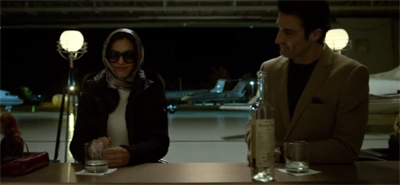
Stick with it.
With that in mind, it seems like the assertion that Frank would not have assassinated Reyes plays into the old “wouldn’t hit a girl” cliché. It is suggested that the audience might find it acceptable for Frank to murder Dutton and Shoonover, but would not tolerate the death of Reyes at the hands of the Punisher. Given that Regrets Only was willing to let Matt take on a female member of the Yakuza, the fact that Reyes was unarmed likely played into this double-standard. Whatever the justification, The Man in the Box paints Frank as a hero.
In fact, Frank’s heroism is explicitly mirrored with that of Matt. Early in The Man in the Box, Matt jumps to protect Karen as the gunman opens fire on Reyes’ office. The sequence is mirrored later on in the episode, when Frank jumps to protect Karen as a hail of bullets rain down on her apartment. The episode consciously invites the comparison; the framing of the two sequences are similar, as are the positions of the bodies involved. In some respects, The Man in the Box serves as a “handover.” Karen was protected by Matt and is now protected by Frank.

Corridors of powerlessness…
The Man in the Box confirms that Frank Castle is operating under his own narrative momentum. For the first two acts of the season, Frank Castle was entwined with Matt Murdock. The first four episodes of the season found Matt trying to apprehend Frank, while the next five followed the trial and incarceration of the Punisher. While both Penny and Dime and Seven Minutes in Heaven were episodes more interested in Frank Castle than Matt Murdock, Frank still existed within Matt’s gravity. Even in Seven Minutes in Heaven, the Kingpin was present.
With The Man in the Box, Frank Castle is engaging on his own quest without Matt Murdock interfering. Matt is tied up in the plot involving the Hand and Elektra. Barring a brief conversation with Frank at the climax of .380 and a momentary interaction in A Cold Day in Hell’s Kitchen, Frank and Matt are on very different paths from here to the end of the season. Frank is still pursuing the people who killed his family while growing into the role of the Punisher. As of The Man in the Box, he is free to do so without Matt Murdock interfering.

Something to chew over…
In many respects, the second season of The Man in the Box is a thirteen-episode superhero origin for Frank Castle. This is somewhat excessive; after all, the need to extend the plot across a full season means that Castle kills the man responsible for the deaths of his family no less than three times. However, the import word here is not “origin.” When it comes to introducing superhero characters, the origin is still very much part of the formula. The key word in discussions of Frank Castle is “superhero.”
The second season commits wholeheartedly to the idea of Frank Castle as a superhero, in a way that feels deeply undeserved. Despite the tension that exists between Frank and Matt throughout the second season, the two still work together at the climax of A Cold Day in Hell’s Kitchen in such a way that seems like they are now close friends. (“Superfriends”, perhaps?) The show questions Frank less and less as the season marches along, with the show seeming to suggest that Frank is just as heroic as Matt; he is just a little more lethal.
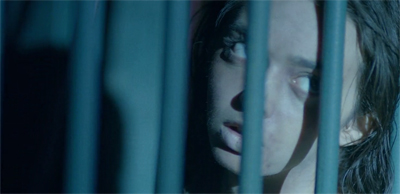
Caged beasts…
Given that Frank is now a protagonist, this leaves a noticeable absence in the structure of the season. Throughout the second season, there has always been a sense that Matt and Frank are moving in parallel rather than opposition; splitting Frank out into his own investigative plot thread only confirms as much. However, it does demonstrate a sizable narrative gap in the season. If both Frank and Elektra are positioned as heroes who team up with Matt at the climax of the season, who might possible stand in opposition?
Certainly not Wilson Fisk. Wilson Fisk only appears in three episodes of the second season, and that includes his one-line cameo at the very end of Guilty as Sin. Fisk is not a major player in the arc of the second season. The Man in the Box treats Fisk as a supporting player, having served most of his plot functions in Seven Minutes in Heaven. Indeed, Fisk only appears in two sequences of The Man in the Box, despite arguably giving the episode its title. One of those two sequences exists primarily to hint at the possibility that the third season might adapt Born Again.

Body of proof.
They tell me little things to keep my interest so I don’t go away, you know? [Laughs] The little bit that I know, I can’t [share], and all I can say is that I’m lucky enough to be able to play this character that I know they really like over at Marvel Television. The little things that I do know are so exciting that for a character actor, it really makes me happy.
It is a nice example of how meticulously and carefully all of these properties are managed that actors can be given a rough plan that extends a year or so into the future.

“I value these conversations.”
However, despite his diminished role in the second season, Wilson Fisk remains one of the most compelling aspects of Daredevil. One of the strongest elements of the first season was the casting. Charlie Cox is horribly underrated as Matt Murdock, particularly during the stretches of the second season where Matt seems to bounce between plot points like a ping pong ball. However, Vincent D’Onofrio is masterful as Wilson Fisk. It is an astonishingly powerful performance, not because it is particularly grounded or naturalistic, but because it understands the tone of the show.
D’Onofrio’s performance is heavily stylised. The actor alters his posture and voice dramatically. He delivers his lines in a bizarre staccato fashion. However, this is not pantomime. Wilson Fisk is very much a fully-formed character, with a strong emotional centre and a great deal of nuance. However, D’Onofrio offers a heightened take on the mobster. Wilson Fisk feels perfectly in keeping with the broader aesthetic of the show. It is a performance that is not afraid to veer into the absurd, while still understanding the psychological reality of its subject.

Up against the wall…
D’Onofrio owns every scene in which he appears. There is a compelling argument to be made that D’Onofrio is the single best thing about the second season of Daredevil, and the second season of Daredevil contains quite a few great things. D’Onofrio’s performance is spectacularly mannered, from the fact that Wilson Fisk fights like a gorilla through to the strange several second pause between the words “such” and “violence” while evaluating Frank Castle’s brutality. Fisk carefully chooses every single word, and D’Onofio carefully makes every performance decision.
The Man in the Box is the only second season episode to feature a scene between Charlie Cox and Vincent D’Onofrio, and it is worth the price of admission alone. The writing staff seem energised writing Fisk, and this energy seems contagious. While the second season has struggled to map clear arcs for Matt Murdock, his character really comes into focus during that conversation with Fisk. The writers (and the actors) understand the two characters perfectly, and there is a spark in their interaction sorely missing from the rest of the season.
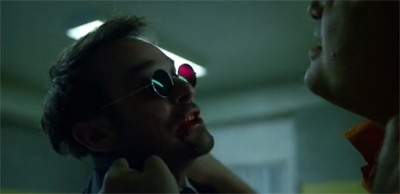
Blindsided.
This is most obvious in the way that Matt and Fisk understand each other perfectly; each can needle the other. Fisk can get under Matt’s skin by talking about how helpless he feels as Hell’s Kitchen tears itself apart. Matt cannot help himself into firing back at Fisk by making reference to Vanessa. The sequence is executed beautifully, with the suggestion being that both Matt and Fisk have been tricked into showing their hands. Matt knows that Fisk runs the prison. Fisk might suspect that Matt is actually Daredevil.
The sequence is delightfully tense, as Fisk lays into Matt. Matt has to consciously choose whether to take the beating or to reveal himself. Fisk’s final scene of the season suggests that Matt might have revealed himself when he landed that quick uppercut. Given how Matt spent the rest of the fight playing possum and taking his licks, it seems entirely possible that the opening blow was reflexive. Matt lands the blow almost as soon as Fisk grabs him. Did Matt’s temper get the better of him? Has Matt been undone by his own arrogance?

The Daredevil’s in the details…
After all, Matt seems to come quite close to revealing himself even in the conversation before the assault. “This is your jungle, this is your blood,” Matt taunts. “Like it is mine.” That seems like a rather strange piece of dialogue to hear from the lawyer who helped to put Fisk away, but it certainly fits more comfortably with the masked vigilante who waged a one-man war with Wilson Fisk to determine the future of Hell’s Kitchen. Even discounting the uppercut, Matt is flying very close to the flame.
The scene between Matt and Fisk is very precise and very meticulous. Even Fisk’s wonderfully demented monologue is very carefully crafted. Laying into Matt, he warns, “While I try to sleep in this bleak place, the one thing that keeps me warm is the thought that I will look down upon this city – the city that birthed me! – with the woman who I love – whom I love! – with everything that I am.” It takes quite an actor to sell something like that, but D’Onofrio is up to the task. More telling are the finer details.
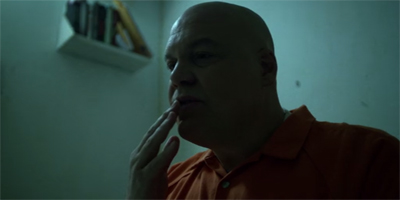
“I thought I recognised that right hook.”
Even in his rage, Fisk corrects a misspoken “who” to “whom.” Given the importance Fisk puts upon the appearance of civilisation, that little slip-up is a delightful character touch. Even while beating an attorney to a bloody pulp, Fisk takes the time and makes the effort to demonstrate that he understands the finer workings of English grammar. He is not an animal, despite all the references to the way that the prison serves to bring out the more animalistic impulses within its inhabitants.
In spite of (or perhaps because of) his limited screentime, Fisk has a much stronger sense of character and purpose than Matt Murdock across the season. The Man in the Box finds itself trying to do far too much with Matt in far too little screentime. Matt has a crisis of faith about the justice system. “I thought it could work, the law,” he confesses to Claire. “But it feels useless. Everything I do just gets undone.” It is an interesting sentiment, particularly for a comic book character who is largely a slave to the status quo. Unfortunately, it feels undercooked.

Quittin’ time…
Where does this character arc come from? It is rooted in the escape of Frank Castle and the Kingpin’s domination of the prison, not to mention the return of the Yakuza-slash-Hand. But where does it come from in terms of character? There is a logical thematic connection to be made back to the debates about Matt’s more violent impulses and whether he is a “half-measure”, but the season does not have enough room left to explore that. More to the point, it does not do enough to connect the dots.
More to the point, where does the arc go from here? What happens to reassure Matt that it can “work” and that his work is not “useless.” There are several obvious possibilities in A Cold Day in Hell’s Kitchen; his redemption of Elektra or the fact that he has saved so many lives that the Hand can fill a building with them. Unfortunately, the show fails to properly connect the dots. Matt’s existential crisis in The Man in the Box feels like pointless melodrama that is forgotten almost as soon as it is written, never integrated into the season.
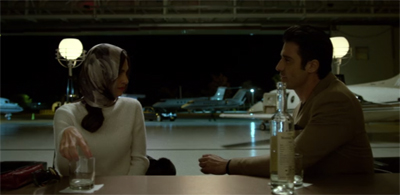
First class assassins.
In fact, Matt seems to consider giving up his secret identity during that same conversation with Claire. “No more friends,” he insists. “At best they’re a distraction. At worst I put them in jeopardy.” It is a bold idea, but one that feels very much in keeping with the character. It is very much a subversion of the classic “Spider-Man no more!” trope, instead suggesting “Matt Murdock no more!” It is certainly a novel approach to the old dilemma of kidnapped girlfriends and murdered allies that plague so many heroes.
Unfortunately, this idea is forgotten almost as quickly as it is brought up. The second season deserves a lot of credit for splitting Matt and Foggy up in The Man in the Box and keeping them split up at the end of A Cold Day in Hell’s Kitchen. However, it is quite clear that the show has no intention of committing to Matt cutting off everybody in his life. The final scene of A Cold Day in Hell’s Kitchen suggests a reconciliation between Matt and Karen. As a result, it seems like Matt’s existential crisis in The Man in the Box is never explored or resolved.

The Hand’s fingerprints are all over this.
Again, the influence of The Dark Knight can be felt on the season. This is roughly the same point in The Dark Knight that Bruce has his own existential crisis following the death of Rachel Dawes and the disfigurement of Harvey Dent. Given that the second season of Daredevil is so fixated upon structure rather than plot, it makes sense that a plot point like this would be dropped into the narrative at this point for no other reason than because it worked well in another earlier story.
This is particularly frustrating because it is one of a number of good ideas that the second season borrows from Ed Brubaker and Michael Lark’s extended run on Daredevil only to squander it needlessly. While Frank Miller remains the heaviest influence on the show, the production team have borrowed heavily from many iterations of the title character. The late second season includes quite a few plot points lifted from Ed Brubaker and Michael Lark’s run on Daredevil, even if they are ultimately executed in a less than satisfying manner.

Hasn’t the foggiest…
The final stretch of Brubaker and Lark’s run focuses on the damage that Matt Murdock has done to the people around him. It finds Matt cutting himself off from his friends and family as the Hand tighten the noose around him. He decides that he should live alone without the companionship of people who could become targets. In many ways, it mirrors the idea suggested in The Man in the Box, right down to the immediacy of a threat posed by an army of undead ninja assassins. That was certainly a more interesting direction than anything the show does with the beat.
The focus on Wilson Fisk and the Punisher locked in prison together in Seven Minutes in Heaven also feels like a nod to Brubaker and Lark’s opening story arc, The Devil in Cell Block D. In that arc, Fisk and Castle find themselves embroiled in a conflict to control (and escape) the prison at Riker’s Island. While there are certainly echoes of that in the second season of Daredevil, there is one major element missing. Brubaker and Lark told that story focusing on Matt Murdock’s arrest and incarceration. The idea of a superhero prison story worked very well.

Can New York’s Finest solve this thing? You Brett your ass they can!
As such, it seems like the second season borrows several trappings from the Brubaker and Lark run. In fact, Matt’s mid-air rescue of Claire in .380 is shot and edited in such a way as to recall a similar aerial rescue from about midway through Brubaker and Lark’s run. Given that Alex Maleev was such a major visual influence on the look and feel of the first season, it is nice to see the second season sharing the love a little bit. Brian Bendis and Alex Maleev were a fantastic Daredevil team, but that does not mean Ed Brubaker and Michael Lark should be overlooked.
There are some problems with this, however. While it makes sense to draw on Ed Brubaker’s plotting for a season so heavily fixated upon the Hand, the second season never uses these plot points as effectively as its source material. Seven Minutes in Heaven is fun, but it is not as great as The Devil in Cell Block D. Matt’s spiritual crisis in The Man in the Box is not a bad idea, but it lacks the same narrative weight as Matt’s breakdown in Lady Bullseye and Return of the King.
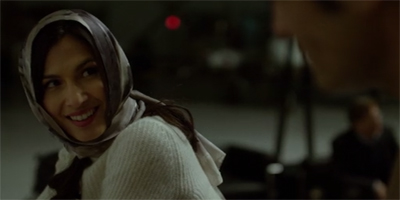
“Leaving? There’s still three episodes to go!”
Storytelling suggests that a television show is less likely to return to a previous narrative set-up for fear of being dismissed as illogical or contrived or derivative. The fact that Seven Minutes in Heaven has already done a “Wilson Fisk and Frank Castle in prison together” story makes it less likely that the show could later fall back on a “Wilson Fisk and Frank Castle and Matt Murdock in prison together” story for fear of being accused of repeating itself. As a result, there is every chance this is as close as the show will come to The Devil in Cell Block D.
This makes Matt’s crisis of identity in The Man in the Box all the more frustrating. There is a great Daredevil story to be told about Matt Murdock giving up his civilian life. Unfortunately, the fact that The Man in the Box botches that story so badly suggests that the series is unlikely to return to that thread for a while. Otherwise, Matt might seem indecisive and paralysed. While Daredevil is willing to suggest that Matt is an extremely flawed hero, it seems unlikely the show would allow him to equivocate on this point.
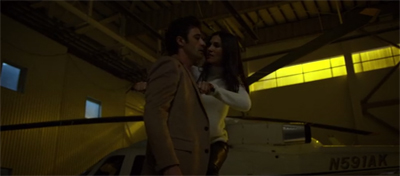
Stickin’ it to the man. Who is named Stick.
The fact that Wilson Fisk works so well in three relatively minor appearances across the season and that the season has mapped out a superhero origin story for Frank Castle points to one of the biggest structural issues with the second season as a whole. The second season lacks a strong primary antagonist. In fact, this likely contributes to the wishy-washy nature of Matt’s characterisation across the season as a whole; Matt lacks a villain against which he might define himself.
Guilty as Sin made it clear that the Hand would be the primary antagonists of the second season of Daredevil. On paper, this made a great deal of sense. The Hand were created by Frank Miller for his run on Daredevil, which is a huge influence on the show. The Hand are tied into the mythology of Daredevil and Elektra, one of the two largest threads running through Miller’s original run. (The other was Wilson Fisk, whose arc drove the first season.) Given their cameo in Stick during the first season, it seems appropriate that they should serve as the season’s antagonists.

To hell with that…
However, there are several problems with the Hand. Ninjas are cool, but they are fairly generic. Ninjas are a great way to add a volume of bad guys to a story. Although Frank Miller gets a lot of credit for developing the psychology of Matt Murdock and Wilson Fisk during his Daredevil run, his artwork was just as influential. Introducing an army of undead ninja allowed Miller to stage any number of kinetic action sequences. Ninjas are cool. However, ninjas are also fairly bland after a while. Once the novelty wears off, they are just stormtroopers or bond henchmen or Nazis.
Even in Frank Miller’s original stories, the Hand could seem rather generic. Miller created a monstrous (and nigh-immortal) ninja named Kirigi who seemed to serve as the most prominent member of the Hand, but the ninja cult provided little more than an excuse for elaborate and kinetic fight sequences. In the context of the early eighties, ninja were still a novelty as they appeared in Daredevil. Over the next few decades, that novelty would wear off. Eventually, the ninja seemed almost passe.
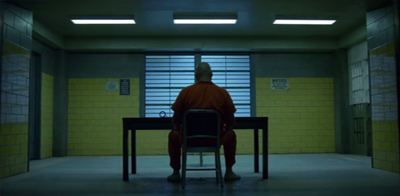
“Season Three is going to be fun.”
While the Hand were exciting in Guilty as Sin, it is hard to maintain that level of excitement across the rest of the season. Movies and television have demonstrated that named characters tend to fare pretty well in combat with unnamed characters, so combat sequences between Daredevil and hordes of anonymous ninja assassins can only generate so much suspense. As the season marches closer and closer to its finalé, the combat sequences become more readily interchangeable, the Hand appearing almost intangible.
To be fair, the show tries to rectify this problem. The final sequence of Seven Minutes in Heaven revealed that the Hand were being led by Nobu, the ninja last seen in Speak of the Devil during the second half of the first season. In that episode, Nobu went head-to-head with Matt Murdock at the behest of Wilson Fisk. That fight exhausted Matt, but he did emerge victorious. Matt set Nobu on fire and the ninja was presumed to be deceased. It seems like a strange choice to bring back a mid-tier “boss” from the first season as the “big bad” of a season.
After all, it is not as if Nobu acquitted himself particularly well. The “death” of Nobu also served to solidify Wilson Fisk’s power, with Fisk cannily manoeuvring Nobu into conflict with Daredevil to satisfy his own ends. More than that, Nobu’s primary accomplishment was beating Daredevil to a bloody pulp so that Fisk could deliver a brutal beatdown. Nobu wasn’t even the character to deal the greatest amount of damage to Matt Murdock in Speak of the Devil, taking a backseat to Wilson Fisk.
In the larger context of the first season, Nobu was never particularly interesting. In terms of Wilson Fisk’s secret cabal (his “underworld avengers”) composed of criminals from all walks of life, Nobu ranked in the lower half of the table. He was certainly more interesting than the child-kidnapping Chechens. However, Nobu never developed the sort of character that made fellow cabal members like Leland Owlsley or Madame Gao so interesting. Nobu was just a perpetually grumpy man who may or may not have been a ninja. (Spoiler: he was a ninja.)
This is not a huge problem of itself. With a bit more time and effort, the second season might be able to flesh Nobu out into a well-rounded and fully-developed character. Unfortunately, hiding his return until the final moments of Seven Minutes in Heaven removes any possibility of developing Nobu from a third-rate antagonist into something more meaningful. Watching the final stretch of the second season, it seems like Nobu ended up taking the slot of “big bad” because there was simply nobody else available. He is no Wilson Fisk. He is not even Kilgrave.
As the second season of Daredevil enters its final act, its endgame comes into focus. Unfortunately, so do its absences and weaknesses.
You might be interested in our other reviews of the second season of Daredevil:
- Bang
- Dogs to a Gunfight
- New York’s Finest
- Penny and Dime
- Kinbaku
- Regrets Only
- Semper Fidelis
- Guilty as Sin
- Seven Minutes in Heaven
- The Man in the Box
- .380
- The Dark at the End of the Tunnel
- A Cold Day in Hell’s Kitchen
Filed under: Television | Tagged: daredevil, kingpin, the hand, villains, wilson fisk |




















Per Vince’s “performance’ in this series:
“It is always said of (Patrick) Stewart that his strength as an actor is his ability to deliver bad dialogue with utter conviction. I say it is time to stop encouraging him. Here’s an idea: Instead of giving him bad dialogue, why not give him good dialogue, and see what he can do with that?” – Ebert
Touché!
In D’Onofrio’s defense, he certainly has at least one “all-time great” performance with Full Metal Jacket, although I remain one of the few people who prefers both Apocalypse Now and Platoon to Full Metal Jacket.
(But I’m curiously ambivalent on Kubrick as a whole. The Shining is my favourite Kubrick film, philistine that I am. I am not bold enough to claim it is his best, but it’s the most enjoyable for me. I really like his other work while being aware of the incredible level of craft on display, even if my enjoyment is never quite has high as my appreciation, if that makes sense.)
I’m enjoying your reviews and they are amazingly in-depth and well-researched; however, they have become very repetitive with the same points being made over and over again about the softening of the Punisher and the generic nature of the Hand, etc. Are there other things you could focus on for the remainder as well?
That’s a very fair point.
It is one of the things I am wary of in doing reviews of contemporary weekly television. I feel I’d just end up repeating myself. I do try to spice things up, talking about D’Onofrio/Fisk here after avoiding talking too much about him (individually) in Guilty as Sin or Seven Minutes in Heaven, for example. But I do find myself returning to the same praise (structure, pulpiness) and criticism (lack of a baddie, characterisation of the Punisher) over and over again.
I’m writing the review of .380 now, and it’s talking about the difficulty of managing the two plot threads concurrently and how that causes issues for characterising Matt. Which I’ve hinted at a bit before, but haven’t looked at in depth. But I can see myself getting drawn into the scene between Karen and the Punisher at the diner, which is really just all of the things I dislike about the second season’s portrayal of the character in a single scene.
With The Dark at the End of the Tunnel, I plan to talk about models of adaptation. But I’m wary of repeating some of the stuff I wrote about specifically adapting Elektra back in Kinbaku or about the specific references to Garth Ennis’ Punisher work in Regrets Only.
This is probably why I work better with shows that are old and which I’ve seen multiple times beginning to end. (The X-Files and Star Trek.) In those cases, I can structure my reviews to avoid repetition by saying “yeah, this is the one episode where I talk about [thing]” or “I’ll put off talking about [thing] until later in the run.”
I know what you mean and I have struggled to diversify my own reviews of this Daredevil run. Though I sounded critical, I do find your reviews so well done and thoughtful and they had me looking at this season again to the extent that I had to stop reading your review before I wrote mine as I was being influenced! As to your main points, I agree with Punisher being softened too much but am happy as Bernthal is just so darn good. I really didn’t warm to Elektra and agree Matt ended up reacting all season rather than acting. You’re also right that Kingpin stole the show. I did enjoy this run though, more so than Jessica Jones and at last it felt like it had 13 eps worth of plot unlike S1.
No worries at all! I’m the first to admit it.
I suspect that there’s a reason for the repetition in how I sat down and wrote the reviews. For the first season and Jessica Jones, I would take a chunk of the season (three/four episodes) and split it out and write them out to avoid repeating myself too strenuously. Due to circumstances outside my control, I’ve been writing the second season more on the fly, without that sort of planning or structuring. In a way, it’s a very “meta” way to review these episodes, which do suffer from a disjointedness and some foundational planning issues.
I still prefer Jessica Jones of the three Marvel Netflix seasons, despite being eight episodes of plot stretched to thirteen episodes. They were eight great episodes. I loved the first season of Daredevil almost a much, because I’m a sucker for telling a simple story well; I think it’s an underrated skill to be able to plot and structure a straightforward narrative, particularly in this day and age. But I also have a massive Daredevil bias. My first Marvel Omnibus was Ed Brubaker’s Daredevil run, bought on a whim. Loved the character ever since.
The second season of Daredevil would be a distant third, although I liked it more on rewatch once I’d made peace with the bigger issues the first time around. There are some great individual episodes; Kinbaku, Guilty as Sin, Seven Minutes in Heaven. But I don’t think it coheres and I think it has fundamental problems with its two central characters.
Are we getting a Batman v Superman review soon?
I was out of the coutnry this week, and so missed the preview. I’m hoping to go next week, if I can find the time.
Hi Darren,
I love your blog and read it pretty regularly. However, I think you missed the point of the “patriarchal s$&@” scene, for two reasons.
1. As Ellison himself implies, the reason he’s ordered police protection for Karen is not because he’s a sexist, but because he thinks that that might protect Karen from the fate that befell Ben Urich. It’s not hard to see that the reason Ellison repeatedly goes out of his way to aid Karen in her crusade because he wishes he’d done the same for Ben.
2. Throughout the series, Karen has a terrible habit of going into dangerous situations alone without a plan. When things inevitably go south, she ends up needing someone like Matt or Frank (or, in one case, Foggy of all people) to bail her out. The fact that she’s completely unable to learn from her mistakes in this area, and that the writers and other characters repeatedly gloss this over, is one of the few things I find genuinely frustrating about the series. Granted, Ellison doesn’t know all this, but the viewers do, and when you couple this with my first point, it’s pretty hard to see how Ellison is in the wrong here.